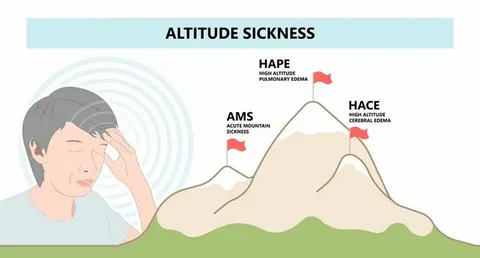To others, it’s the opportunity of a lifetime. Filed in travel, Nepal trek. On March 9, 2020, Everest Base Camp Trek – A dream come true for many trekkers. Everest Base Camp Trek, A trek to the Everest Base Camp[EBC] is the dream come true of many trekking overweight. But not all things are ugly in life at altitude, way to the EBC trek: you are also ill and at your worst. It’s a malaise that can strike just about anyone, regardless of how fit and hill-hardened you might be pleased to consider yourself… and YES, it can happen to YOU! Indicators, prevention, and treatment are also critical to help make for a safe and a hit trek.
There’s no foolproof approach for warding off altitude illness, and it’s not pretty much being tough but as a substitute being knowledgeable, organized, and in sync with your body. Your front-line how-to for outsmarting altitude illness and basking in the glow of the highest and mightiest mountain variety within the international.
Understanding Altitude Sickness
Everest Base Camp Trek Itinerary Altitude illness is what takes place when your body isn’t used to receiving less oxygen (which takes place when you ascend higher). The climb from Lukla, at approximately 2,800 meters (about 9,200 feet), to Base Camp, at 364 meters (around 17,598 feet), becomes one of the grueling milestones along the route to Everest. And it is that coming-up-quick that can knock even experienced trekkers off balance.
Headache, dizziness, nausea, fatigue, dyspnea, ear, and insomnia are commonly reported symptoms. They are mild symptoms and can be controlled, led, but once not alleviated, the stage is set for disasters such as HAPE and HACE.
The answer is early detection and piling on the treatment.
Avoid Altitude Sickness with a Bit of Mountain Magic.
Ascend Slowly and Steadily
Everest Base Camp Trek package Your body needs to acclimate. Climbing slowly is the surest way to avoid illness. Some of those itineraries will also include extra rest and acclimatization days — take them.
Rule of thumb: If you’re going to sleep over 3,000 meters (about 9,800 feet), don’t climb more than 300 to 500 meters 1,000 to 1,600 feet) In a day. Climb excessively, sleep low. Go to the altitude for the day, then sleep at a decrease elevation.
Hydrate, Hydrate, Hydrate
Dehydration makes AMS symptoms worse. And drink a minimum of 3-4 liters of water (or, if you are imperial, 80 – 100 ounces or so) daily, every single day, whether you “feel” like it or not! Carry with you Purified water, a good water filter, or purification tablets when moving. “I would stay away from the alcohol and not go crazy with the caffeine,” which can be dehydrating.
Eat Well and Rest Often
The novelist Robert Graves’s first few nights of sleepless agony had been endured as “the body’s protest against an unnatural environment.” And your body’s on that late-late shift trying to compensate. Feed it high-calorie, soft foods. Carbs for fuel today, proteins to help you get up in the morning.
Rest is just as important. “I’m just way more in tune with my body — you don’t push through something when you feel a tired spot. Sleep may be an issue at higher altitudes, so rest when you can.
Know Your Medication Options
The drug most frequently used by trekkers is acetazolamide (Diamox). It can also be used to simulate acclimatisation by stimulating hyperventilation and higher oxygen consumption. Talk to your medical doctor before you journey to make certain your circumstance warrants it and to find out how and when you must take over-the-counter medications.
Ache medicines consisting of ibuprofen can alleviate over-the-counter headaches, howeverr not AMS.NEVER medicate major symptoms ever ever ever- medicine is a band-aid, not a cure.
Early Warning System: At What Point Do We Declare a Code Red?
Early altitude sickness feels like being tired or having a cold. And reject migraines or nausea, or vertigo as mere sleepiness. Don’t get care if: If you have not gotten better after resting and drinking fluids, or if you have gotten worse, you need to: Do get care right away if/you may have an injury or feel very weak.
But there are also some other, more serious symptoms of the altitude sickness you or a friend might be experiencing, such as confusion, lack of coordination, coughing up a frothy pink spittle, and you feel you have to gasp for breath — in which case, don’t wait for local help to arrive, descend (not “descend” as the Portugese dude says in the video) or fly down and then get some help. There’s no time to lose, because a mere climb of a few hundred metres can be the difference between living and dying.
Practical Tips During Your Trek
Don’t panic: You don’t have to go sprinting madly to the next town. Breathe, and take a break.
Avoid Overexertion: Take breaks often. Take a breath and stretch while soaking up the views.
No Smoking and Alcohol both alter oxygen delivery, possibly to the effect of AMS.
Concise Trekkin: The slower you can get weight off your legs, the faster you can exhale.
Communicate: Whether you’re out with a guide, a group, or solo, make sure you don’t understate what your body is experiencing. Don’t push through symptoms alone.
Smartest Mind Game: Positive and Cool
Altitude sickness is half-mental, too. Covid symptoms can heighten anxiety, too, and already feeling like you can’t breathe is a surefire way to make anxiety worse — a feedback loop. And you can relax through practices like mindfulness.”
Recollect, it’s no longer a race. The mountain will not have removed itself. (Yes, of course, your health and safety are top priority, do it 00 percent your way, hear you, you just maybe have a few answers after all.)
When the Best Health Cure is Rest
You can live on the money and still be clobbered with altitude sickness. There’s only one thing that will save you, and that’s descending rapidly (and preferably at a lower elevation before you keel over). Returning is strength, not weakness.
The fields’ grass died, and although some grass grew back, a lot did not — the barest of windward strands for beachgoers and surfers who will still be able to go to the beach, but barely. Don’t kill yourself from “summit fever.”
Final Thoughts
The way you deal with altitude sickness is not that you don’t get it, it’s how you come down from that, and when to be sane, and when not to be, and you just do a little grappling there. Just be sure to climb slowly, drink up, eat well, and check in with your body, and you’re doing your part to make sure you have the best chances to see the incredible beauty without any fear of danger, from being able to safely reach Everest Base Camp.
You walk the tough physical and the emotional/spiritual walk of the strong: running the race, never giving up, and not allowing yourself to be defeated. You will see yourself driving toward an adventure more unique than anyone else in the world — and how you return with memories, not regrets.







